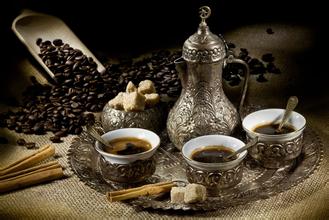A simple analysis of the knowledge of coffee roasting and coffee blending
Coffee begins with "origin" and "flavor," and of course,"variety," because initially people only consume coffee grown in their neighborhood. However, as trade developed, coffee varieties gradually mixed. Today, coffee is essentially a blended beverage--like champagne or certain wines--although good coffees from a single variety or origin can be quoted directly. Indeed, some people believe that the best coffee is a blend of the best qualities of different coffees-bright acidity in one, floral richness in another, and full-bodied taste in another.
Blending has been around as an art form for a long time-Mocha Mysore is a popular combination of two different varieties of coffee, combining the mild aromas of Mysore with the intense flavors of Mocha-but it has generally been for commercial purposes only. The primary purpose of Robusta Arabica blends is to lower its price, and it is undeniable that almost all blends created can produce better economic profits than single varieties sold separately.
The key to matching is that the properties must be consistent. All commercial blends strive for consistency, and some of them are excellent, such as Paulig in Finland, Gevalia, Zeogas and Avid Norquis in Sweden, and DonweEgberts in the Netherlands, all of which are unique premium blends.
Breakfast coffee is an ideal choice for those who are new to coffee drinking. It's a carefully roasted coffee, usually a blend of African coffee with milk, or a blend of two medium-roasted Kenyan and Colombia coffees to start your day fresh and fragrant. After-meal coffee blends use the same ingredients, only roast them deeper to extract more flavor. One of the best is Indonesian coffee, which is also mixed with a little Kenyan and Costa Rican coffee, so that the coffee blended into a more unique and elegant flavor.
Those already rich, deep-roasted coffees have a distinct bitterness on first taste, but you'll soon get used to it. The most intense coffee is the deep-roasted continental blend, made espresso, which is popular throughout southern Italy for its bitter taste but rarely used elsewhere. In northern Italy, however, blended coffee is lighter roasted, with a uniform coffee texture and mild acidity, such as fine wine.
Nothing prevents you from creating your own blend, but mixing two diametrically opposed beans, such as Ethiopia and Sumatra, is not advocated. When the two are mixed, the Ethiopian bean's alcohol flavor makes the Sumatra bean's strong flavor smell like earthy. But you can always try to combine Colombia beans with Sumatra beans, or try a mixture of dark and light baked beans to find the best combination between the two.
For those who want coffee that tastes light and not bitter, Arabica such as Colombia beans or Tanzanian Chagga can be tried, although Chagga has a slight acidity. For coffee with a strong flavor, it depends on how well it is roasted. Of course, for coffee, especially soft varieties like Brazil and Costa Rica, you can roast them deep and strong, but they can't be any more bitter. But if you add a little bit of Robusta to it, you get a slightly astringent, somewhat bold flavor. You can mix different flavors and traits in different blends. Chagga-Java-Mocha is a good example, which contains the mellow taste of Java, the soft acidity of Chagga and the rich texture of Mocha.
The ideal way is to buy a small amount of raw beans, roast them yourself, and grind them directly before making coffee. Most of us, however, have to buy baked beans, and that number may rise in the near future.
When storing beans, the biggest enemy is moisture. The volatile oils that give us our aromas are soluble in water, and moisture affects the oils. Don't store coffee in the refrigerator because once it's opened, moisture condenses on the surface of the container.
If you want to keep coffee well stored at any time, the best way is to put it in a freezer and make sure it is sealed in an airtight bag. Roasted beans can be stored in the freezer for more than a week. When you need them, don't try to thaw the beans, just put them in the grinder.
Coffee's other enemy is oxygen, which breaks down volatile aromatic oils. This is why it is important to grind the beans directly before brewing coffee. When coffee is ground, its surface layer is exposed to the air, which means that the aromatic oil begins to evaporate and the flavor disappears into the air.
Don't store coffee next to strong tasting products such as tea. Coffee quickly absorbs the flavor of other substances.
If you buy coffee by mail, it's best to buy small quantities at a time. Even in larger quantities, you lose the value of the coffee, just as you lose its aroma.
American consumers now have a choice of more than 100 flavored coffees, many of which are exported. Flavor coffee is produced by coating roasted beans with a carrier oil and letting them spray quickly in the aroma. This practice began in the United States in the 1970s.
The most popular flavors are cocoa, mocha, bitter almonds and double cocoa. Orange liqueur and nutty flavours are also present, although serious coffee drinkers will underline raspberry, banana and creamy beans to make a clear distinction. The new coffee flavor introduced in the West is cardamom, which has long been added to coffee in the Middle East and is a popular and traditional additive in Mexico.
One problem for small shops and strict coffee drinkers is that they need separate grinders for different coffee flavors, because any residue affects the taste of the next ground bean. When preparing a new flavor of coffee, you may find it necessary to buy a small and inexpensive grinder, or buy pre-ground coffee.
The top three coffee flavors most widely used in France and the United States are almond, vanilla and hazelnut. They sell best in the summer, when coffee is usually drunk less often and iced coffee is the most pleasant option.
The phrase "coffee without caffeine doesn't taste like coffee" is only partially true. Caffeine itself has no particular taste except for a slight bitterness. When caffeine is removed, the taste is different, probably because other substances that contain aromas are also removed.
The decaffeinated green beans from all over the world are transported to Germany or Switzerland, where they are processed and sent to roasting centers around the world. Mexican green beans are often sent to Switzerland decaffeinated, then sent across the Atlantic to roasters in Santiago, and then returned to the country of origin.
Early decaf coffee referred to a method in which green beans expanded under high temperature steam, absorbed caffeine-destroying solvents, and then released the solvents and their residues under high temperature steam conditions. Then the factory packs them with methylene chloride, which protects them from other smells. However, methylene chloride was banned in Europe in 1995 because it can destroy the ozone layer when released into the air.
There is a method that requires only water and an activated carbon processor called Swiss Water Treatment. The process, patented by Coffex SA, is complex and expensive. include immersing that bean in water to remove caffeine and aromatic substances. Caffeine is removed in water by an activated carbon processor and beans are roasted. But the aroma is still in the water, so the water evaporates to concentrate it and spray it back onto the dried beans.
In recent years, coffee tastes have been changing around the world. As we have seen, the fastest and greatest change has been in the United States. Many coffee lovers are hoping that European countries will follow the lead of the United States in introducing more manor coffee and origin coffee. Traditional European coffee sales are varietal blends or simply a simple "Guatemala." The benefits of blending coffee varieties over a wide variety of origins are consistency over long distances, less breakage, and simpler methods of preparation. However, these coffees do not meet the criteria for a real cup of Yauco Selecto or Kona. Now, the outlook for them and for those refined coffees is better than ever.

Source: Brista's blog
Important Notice :
前街咖啡 FrontStreet Coffee has moved to new addredd:
FrontStreet Coffee Address: 315,Donghua East Road,GuangZhou
Tel:020 38364473
- Prev

How to drink the ice drop coffee with the latest introduction of the production method? What's the difference between ice droplets and cold coffee?
I once read a report: Mr. Timko, the boss of an American boutique coffee company, felt very distinctive after seeing ice drop coffee in Japan, and fell in love with it after tasting it, so he studied and promoted it. Ice drop coffee, also known as water drop coffee, ice brewed coffee, is a way to make coffee drinks. Ice drop coffee
- Next

Boutique coffee knowledge Arabica coffee making method
When Europeans first came into contact with coffee, they called the seductive drink Arabian wine, and when conservative Catholics cursed coffee as the devil's drink, they never thought of what a precious thing they inherited from the pagans. As the first region in the world to drink and produce coffee, Arab coffee culture is like it.
Related
- Beginners will see the "Coffee pull flower" guide!
- What is the difference between ice blog purified milk and ordinary milk coffee?
- Why is the Philippines the largest producer of crops in Liberia?
- For coffee extraction, should the fine powder be retained?
- How does extracted espresso fill pressed powder? How much strength does it take to press the powder?
- How to make jasmine cold extract coffee? Is the jasmine + latte good?
- Will this little toy really make the coffee taste better? How does Lily Drip affect coffee extraction?
- Will the action of slapping the filter cup also affect coffee extraction?
- What's the difference between powder-to-water ratio and powder-to-liquid ratio?
- What is the Ethiopian local species? What does it have to do with Heirloom native species?

